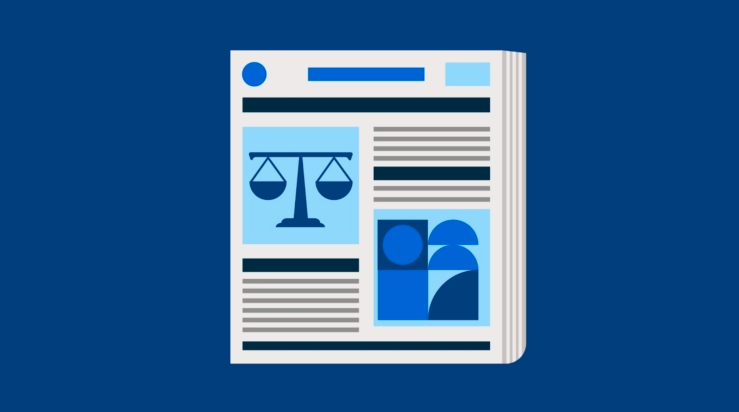Since 2016, legal experts have turned to Clio’s annual Legal Trends Report for a thorough examination of trends in the legal field.
As the most comprehensive analysis of the legal industry, the Legal Trends Report consolidates vital information on law firm performance while illuminating the influential factors driving changes in legal practice.
For lawyers in mid-sized firms, we provide unique insights with our annual Legal Trends for Mid-Sized Law Firms report. We’re thrilled to announce the recent release of the 2025 Legal Trends for Mid-Sized Law Firms report. This report examines key trends shaping mid-sized law firms across multiple perspectives, providing the data and insights needed for mid-sized law firms to navigate industry shifts and position themselves for long-term success.
Below, we’ll explore key highlights from the 2025 Legal Trends for Mid-Sized Law Firms report. Or skip ahead to download the 2025 Legal Trends for Mid-Sized Law Firms report and get even more insights on AI, alternative payment options, client marketing, firm spending, and more!
Mid-sized firms leverage more and higher billing rates than smaller firms
For the first time, the Legal Trends for Mid-Sized Law Firms report is exploring (NA) hourly rates by firm size and how they differ within firms to provide more insight into the nuances of size in relation to industry averages.
Here, we see that practically all mid-sized law firms leverage multiple billing rates and generally charge a higher number of different hourly rates for both lawyers and non-lawyers compared to smaller firms. Additionally, mid-sized law firms charge higher average hourly rates than smaller firms for both their lawyers and non-lawyer professionals, and see greater variation in the rates charged between different timekeepers than smaller firms.
Data-driven insights on billing rates in mid-sized law firms
- 99% of mid-sized law firms have multiple billing rates set for their lawyers, compared to 85% of smaller firms.
- The average mid-sized firm charges eight different hourly rates for their lawyers and nine for non-lawyer professionals, while smaller firms only charge three for both.
- The average difference in mid-sized law firm hourly rates between their top and bottom lawyers is $400, while the average difference in smaller firms is around $250.

Most mid-sized law firms are using AI in some capacity, while over half have adopted AI widely or universally
In the 2024 Legal Trends for Mid-Sized Law Firms report, we found that 19% of mid-sized and smaller law firms were using AI in their practice.
Over the last year, that number has skyrocketed: a whopping 93% of surveyed legal professionals in mid-sized law firms are now using AI in some capacity in their practice, while over half (51%) have adopted AI widely or universally. What’s more, over four in five legal professionals in mid-sized and smaller firms believe that the usage of AI will increase in the next 12 months.
Mid-sized firms are using a wide range of AI tools, with AI-powered legal research platforms, generic non-legal AI tools, and document drafting or automation tools being the most popular options.
Why are so many mid-sized firms turning to AI use? Legal professionals in mid-sized law firms believe that AI will save them time and money while increasing their quality of work and productivity. They are also more likely to believe that using AI increases client engagement and allows them to take on more clients than smaller firms.
Must-know statistics on mid-sized law firms’ AI use
- A remarkable 93% of surveyed legal professionals in mid-sized law firms are now using AI in some capacity in their practice, while over half (51%) have adopted AI widely or universally.
- Mid-sized firms are significantly more likely to have adopted AI than smaller firms: 72% of smaller firms are using AI in some capacity in their practice, while only 10% have adopted AI widely or universally.
- Among mid-sized firms currently using AI, AI-powered legal research platforms (66%), generic non-legal AI tools (65%), and document drafting or automation tools (60%) enjoy the most widespread usage. Predictive legal analytics (52%) and eDiscovery solutions (53%) are also popular.
- Over four in five legal professionals in mid-sized and smaller firms believe that the usage of AI will increase in the next 12 months.
- The top benefits of AI, according to mid-sized firms, are saving time and increasing efficiency (43%), improving the quality of work (38%), and managing caseloads more productively (37%).
You may like these posts
- 2025 Legal Trends for Mid-Sized Law Firms
- Latest Legal Trends Report: AI Adoption in the UK
- Latest Legal Trends Report: Fixed Fees - The Future of Billing In The UK?
- The Latest Legal Trends Report: Marketing and Client Engagement at UK Law Firms
- The Latest Legal Trends Report: What UK Law Firm Expenses Lead to Growth?
Mid-sized firms are embracing flat fees as clients demand predictable pricing
Mid-sized firms appear to understand the benefits of offering fixed/flat fees. Flat fees are the most commonly reported billing method among mid-sized law firms, followed by hourly rates, contingency fee agreements, and subscription models.
Compared to smaller firms, mid-sized law firms are much less likely to offer hourly rates but much more likely to offer subscription models. This shift highlights a growing recognition among mid-sized firms that predictable, transparent, and client-friendly pricing is key to remaining competitive.
As it turns out, clients also want to pay a fixed fee. When we look at client preferences, flat fees are the most preferred way to pay for legal services. Further, over half of potential clients would prefer to pay their lawyers using modern service delivery models, such as flat fees or subscriptions.
Key findings regarding firm billing models
- 64% of mid-sized firms report fixed fee billing models, while 54% use hourly rates, 30% use contingency fees, and 27% use subscription models.
- Among mid-sized law firms offering flat fees as a payment option, 82% used flat fees for the entire matter, while 41% used flat fees for specific activities within a matter.
Webinar: Navigating the Future: Key Legal Trends for Mid-Sized Firms in 2025

Clio features help mid-sized firms improve their revenue, conversion rates, and time to hire
Mid-sized firms are using a range of channels to promote their services, including websites, referrals, online reviews, social media, and internet search or SEO optimisation consultants. Compared with smaller firms, however, mid-sized firms are less likely to rely on referrals to promote or market their services, since they have more resources, allowing them to focus on a wider range of marketing channels. However, both mid-sized and smaller firms report that referrals are their highest sources of leads.
There is a strong correlation between use of Clio features and increased client intake performance. Specifically, mid-sized firms using e-signatures, online schedulers, and online intake forms saw higher revenues, better conversion rates, and faster time to hire.
What to know about improved client intake performance
- Leads: 16% of mid-sized firms report that referrals are their highest source of leads, while 51% of smaller firms report the same.
- Revenue: We saw 20% higher revenue among firms using e-signatures, online schedulers, and online intake forms.
- Conversion rates: We saw improved conversion rates among firms using e-signatures (12%), online intake forms (12%), and online schedulers (10%).
- Time to hire: We saw improved conversion rates among firms using online schedulers (15%) and online intake forms (14%).
Mid-sized firms are investing in software, but lag behind in cloud-based LPM adoption
For the average mid-sized law firm, staff salaries are the largest expense, making up 41% of total costs. In other words, mid-sized firms are paying a little under half of their expenses to their people. Otherwise, rent, marketing, and office expenses—the next three largest spending areas—typically make up a combined 16% of spending.
Notably, the average mid-sized firm spends 2% of its expenses on software—nearly twice the U.S. Census industry estimate—and puts a higher proportion of their expenses towards software than smaller firms.
For mid-sized law firms, cloud-based data storage, video conferencing, electronic signatures, online and electronic payments, accounting software, and cloud-based practice management software are among the most popular technologies. However, mid-sized firms are lagging behind on cloud-based legal practice management (LPM) software adoption. Only 38% of mid-sized firms use LPM software, compared to 71% of smaller firms.
Our findings on mid-sized firm spending and adoption habits
- The top expenses among mid-sized firms are staff salaries (41%), other expenses (28%), rent (6%), marketing (5%), office expenses (5%), insurance (5%), partner salaries (4%), professional fees (4%), and software (2%).
- The average mid-sized law firm spends 2% of its expenses on software—nearly twice the U.S. Census industry estimate.
- The most popular technology among mid-sized law firms include cloud-based data storage tools (50%), video conferencing (45%), electronic signature tools (45%), online or electronic payments tools (41%), and accounting software (39%).
- Only 38% of mid-sized firms use LPM software compared to 71% of smaller firms.

The final word on the 2025 Legal Trends for Mid-Sized Law Firms report
Mid-sized law firms are rapidly embracing AI, shedding their reputation as legaltech laggards. This shift isn’t just about relevance—it’s a strategic response to market pressures and client expectations, positioning these firms as industry leaders.
With AI adoption comes the need to rethink billing models. Many mid-sized firms are turning to flat/fixed fees and subscription pricing to meet client demands for transparency. Yet, hourly billing remains essential, with these firms using more varied rates than smaller firms, reflecting greater specialisation. Regularly reviewing billing practices is key to staying competitive.
Success now depends on more than legal expertise—firms must attract and retain clients by understanding where they search for lawyers and what influences their choices. Assessing ROI and leveraging technology to boost client conversion and hiring speed are critical.
To secure long-term success, mid-sized firms must also invest wisely. Increasing adoption of cloud-based legal practice management software—where they lag behind smaller firms—could offer significant advantages.
Ready to dive into these topics in more detail? Download the 2025 Legal Trends for Mid-Sized Law Firms report!
We published this blog post in March 2025. Last updated: .
Posted in: Clio, Technology
Explore AI insights in our latest report
Our latest Legal Trends Report explores the shifting attitudes toward AI in the legal profession and the opportunities it brings for law firm billing, marketing, and more.
Read the report







